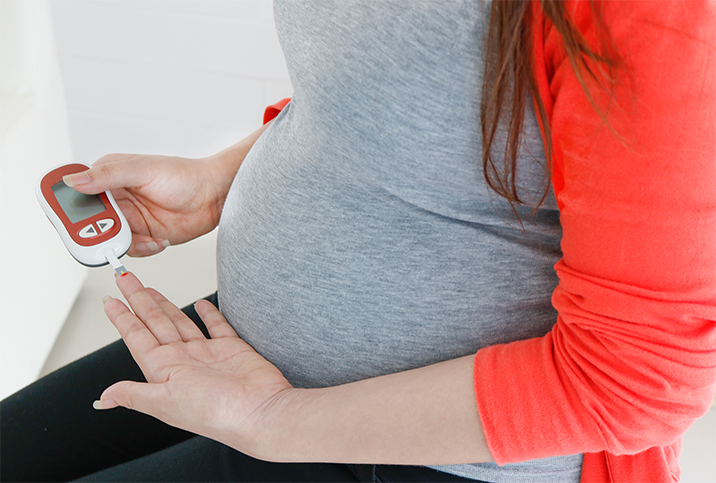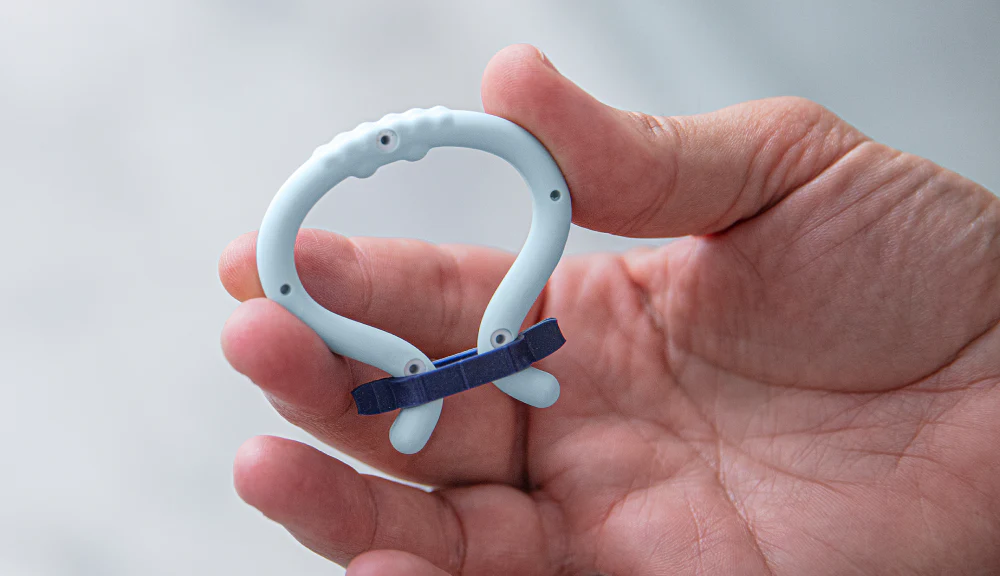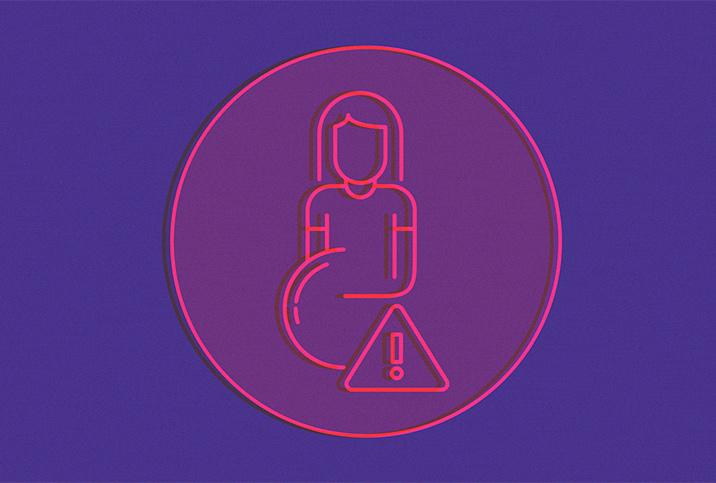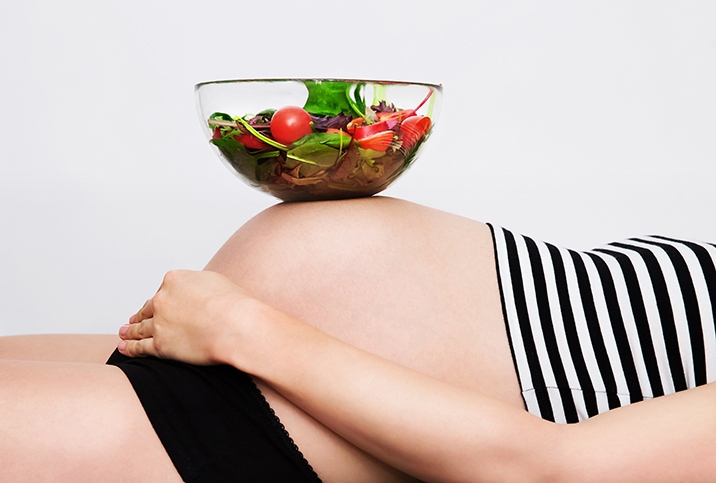What You Need to Know About Gestational Diabetes

The hormonal changes that occur during pregnancy do a lot to support a baby and get the body ready to give birth—they increase blood flow, expand the uterus and start to produce breast milk.
But hormonal fluctuations may also be responsible for causing gestational diabetes, which occurs in 2-10 percent of pregnancies in the U.S., according to the Centers for Disease Control and Prevention.
Gestational diabetes, like types 1 and 2, disrupts insulin and blood glucose levels, and can pose serious risks to both the mother and the baby. The condition is associated with high blood pressure and increased chances of C-section birth—plus about half of women with GD go on to develop type 2 diabetes.
An overview of gestational diabetes
Though there is no concrete origin for the development of gestational diabetes, researchers have posited it is in part due to the varied hormone levels that occur during pregnancy. "While type 1 diabetics produce no insulin at all, women with gestational diabetes can usually make most of their own," said Sudipa Sarkar, M.D., assistant professor of medicine at Johns Hopkins, who specializes in endocrinology. "Some can control it with diet, but for others, diet alone is insufficient."
Doctors will traditionally test for GD when the mother is between 24 and 28 weeks pregnant, though the National Institutes for Health recently announced that it is supporting research to look into the timing of the test and whether diagnosis should take place earlier. Most patients don't have significant symptoms other than frequent urination and excessive thirst, and there are sometimes no signs at all.
"If you're putting on a lot of weight even if you're eating healthy, it could be a sign," said Kathleen Goodman, M.D., an OB-GYN at South Miami Hospital. Discrepancies between diet and activity level versus weight can be an indication.
When a woman is pregnant, the body struggles to operate at full capacity amidst all the changes, leading to myriad problems. The insulin resistance that occurs with gestational diabetes causes blood sugar levels to rise to the point of hyperglycemia, which prevents glucose from leaving the blood and being converted to energy for the mother and child.
Connections to prenatal health
While a unanimous conclusion has yet to be drawn, there are several risk factors that make GD more likely for certain women, such as family history, diet, exercise and weight, said Goodman.
Being overweight or obese has a strong correlation to GD, as does being sedentary. If a mother has previously had a heavy baby (one weighing 9 pounds or more), she is at increased risk.
Ethnicity plays an important role in developmental likelihood. "Certain ethnic groups have a higher prevalence of gestational diabetes, such as minorities," Sarkar said. Women with polycystic ovary syndrome (PCOS) are at a higher risk as well.
Entrepreneur and McCord List founder Rachel McCord speaks with Marisa Sullivan about her struggles with gestational diabetes. Watch the full interview here.
Negative effects of gestational diabetes
Along with monopolizing the amount of blood glucose and insulin in the body, gestational diabetes can have dire consequences for both parties. These can occur throughout and past the gestation process.
For the mother
The hormonal disturbances do not end with diabetic symptoms. There is also a risk of high blood pressure and preeclampsia, which cause further damage to other organs, including the liver and kidneys. This disruption, consequently, prevents these organs from performing their usual waste filter duties, which is especially important during pregnancy.
Another potential issue is the elevated risk for needing a surgical birth (C-section). "The main concern is for large babies that complicate the delivery. [This] can be dangerous for the mother and child because it makes the delivery logistically complicated," Sarkar said.
Furthermore, mothers with GD have a greater chance of recurrence. As Goodman said, "At least 50 percent of women get it after pregnancy, and they are more likely to get it again with future pregnancies."
For the baby
Along with high birth weight, the baby is at a higher risk of developing several other conditions. They are more likely to be born preterm (early), which can lead to further complications.
These infants can experience low blood sugar (hypoglycemia), which has the potential to trigger a seizure in rare cases. Respiratory obstructions are another threat that stems from excessive birth weight.
Additionally, there is a higher risk that these infants will develop obesity and type 2 diabetes in the future.
Stillbirth is also more likely in women with GD. Although the reason is unclear, doctors liken this risk to poor blood glucose level control and changes in blood vessels.
Symptom management
The good news is that gestational diabetes is manageable. "I take care of patients with it, and it's something that can be challenging in addition to other pregnancy challenges. It can be treated and requires close coordination with clinical providers," Sarkar said. Diet and activity changes are the most effective ways for control and prevention.
Dietary adjustments, especially, are key. "To keep glucose even, avoid carbs, moderate fruits and veggies, count calories, no sugars and no fats," recommended Goodman.
"I was already active with a toddler, so I just changed my diet a bit. Cutting out soda and desserts was a game changer," said Abby M., a 26-year-old mother of two from Oklahoma who experienced gestational diabetes with her second pregnancy. "I limited my intake of sugars and carbs to get my blood sugar closer to target numbers."
Additionally, at least 30 minutes of physical activity each day can aid in weight management.
Final thoughts
Though there is still much research to be done on gestational diabetes, what scientists do know has provided women with methods to help combat this condition.
"It helped me to look at it as an opportunity to better my health and well-being. It was challenging to cook new recipes that fit my dietary needs, but rewarding to create new dishes," Abby said. "Also, it helps to remind yourself that it is temporary, just as the whole pregnancy thing is."

















